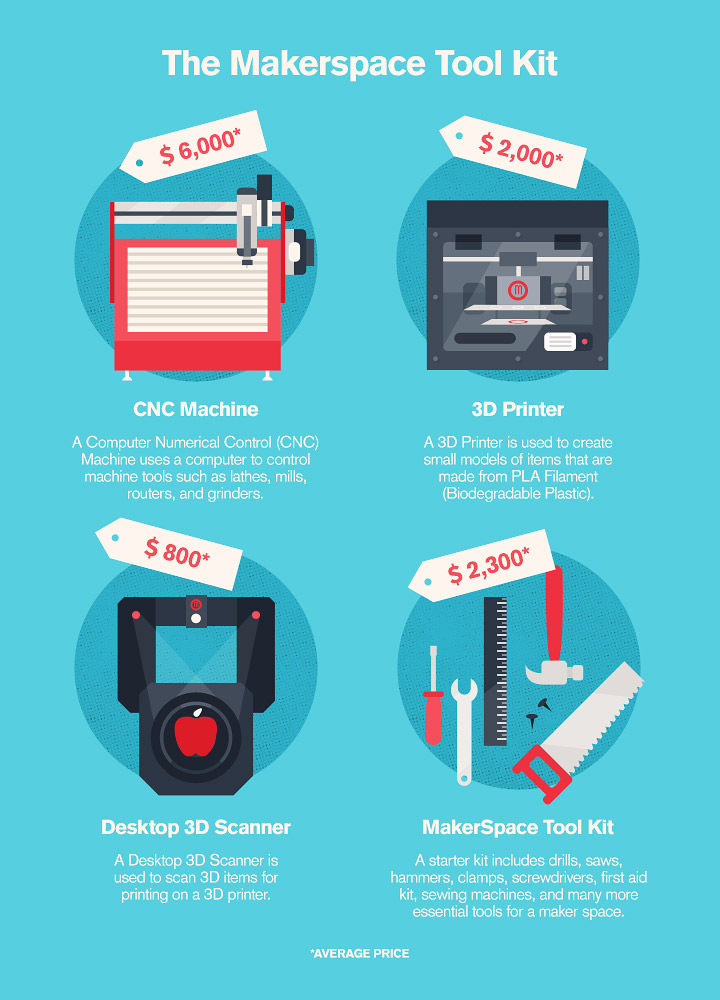Since the first wheels of mass production started turning during the Industrial Revolution, fine craftsmen and DIYers have found it more difficult to sustain their crafts. Until recently, those handmade-focused entrepreneurs who wanted or needed access to the latest technology would have to assemble a large amount of capital for items such as 3D printers or CNC machines. Those who couldn’t afford the high overhead were left to envy those wares and hope for a price decrease.
Today, instead of taking out a second mortgage to fund a workshop, artists, tinkerers, engineers, and gadget nerds across the country are pooling their financial and creative resources to establish the next wave of manufacturing.
 “Makerspaces” are the 21st-century solution to the wastes and excesses of the old industrial model of production. They lower the entry fee into the competitive market, and serve as community hubs and hands-on education centers.
“Makerspaces” are the 21st-century solution to the wastes and excesses of the old industrial model of production. They lower the entry fee into the competitive market, and serve as community hubs and hands-on education centers.
Makerspaces began to spread throughout Europe and North America in the early 2000s. Also referred to as FabLabs or Hackerspaces, they began in the mid-1990s in Germany as collectives of programmers. Some of the first, named c-base and the Chaos Computer Club, inspired U.S. hackers during a Chaos Communication Camp meeting in 2007. Soon after, makers established the first fledgling spaces in New York, Washington, D.C., and San Francisco.
As membership grew, hackers began to purchase more equipment and work on physical objects as well as create code. Some started to use the word “make” instead of “hack” in order to distance themselves from the negative connotation of subverting computer programs, as well as encourage a more creative and community-oriented ethos.
Some now differentiate hackerspaces, which typically focus on computers and programming, from makerspaces. Makerspaces are typically facilities centered on crafting rather than repurposing hardware. According to hackerspaces.org, there are currently 1,762 active spaces across the globe with 350 in development. Of those, MAKE Magazine has cataloged over 100 within the U.S.

Makerspaces have grown in popularity during the last ten years, spawning successful business such as MakerBot Industries and MakerFaires in metro areas to showcase the best of the community’s efforts. Sponsored by MAKE magazine, these events in places such as San Mateo (CA), New York, Austin, Washington D.C., Detroit, and Kansas City, draw thousands of makers and spectators. Giant kinetic sculptures sit alongside workshop pavilions and food trucks, while lecturers, tech reviewers, and musical guests discuss the art of turning imagination into reality. On a smaller scale, independently organized Mini Maker Faires in local communities are also excellent introductions to the maker culture and networking opportunities for established craftspeople.
In June 2014, the White House hosted its first MakerFaire, featuring 100 makers from 25 states in 30 exhibits. President Obama toured the Faire and addressed the makers. The Small Business Administration also announced its $2.5 million Accelerator competition to encourage communities to include startup accelerators and Maker spaces for entrepreneurs in regional entrepreneurship strategies.
Shared resources and on-demand fabrication of goods not only helps human enterprises flourish, but also has marked benefits for the environment. Fixing broken furniture or electronics becomes much simpler with the help of a soldering iron or 3D printed component, and mending clothing is less of a headache when a serger or sewing machine is close at hand. Found materials can be given new life through the vision of a crafts person, and the professional polish of a laser cutter, welder, or lathe.
Having one central location for storage and fabrication can centralize materials and equipment and encourage resource sharing. With a smaller physical footprint in a living space, makers can reduce personal energy consumption and find homes for unwanted, excess bits and pieces. A collaborative environment ensures that ideas are developed from concept to finish. If a knowledgeable friend can restore a busted gadget, it is much less likely to end up in a landfill.
“The Maker Movement and sustainability go hand in hand,” says central California-based SLO MakerSpace co-founder Clint Slaughter. “The trends toward fixing instead of trashing, DIY instead of buying cheaply made goods from across the globe, and upcycling along with recycling have allowed millions to learn new skills, hack things to better suit their own needs, and even make a living just being a Maker. MakerSpaces are not only a place people to build, learn, and hack for themselves, they’re also spaces that generate community and connections between people. We’ve already seen a number of people get jobs, start businesses, build prototypes, and find new opportunities through our space.”
Like any other cooperative, rules governing everything from the use of tools and storage space to cleaning up messes vary at each space. Every makerspace is governed by a loose set of principles that can be adjusted to suit the character and needs of its users. Websites such as makerspace.com and makezine.com offer online guides to starting a workshop, reviews on new equipment, and project inspiration. Yet the nitty gritty details of how to shop for real estate and work through the permitting process is often a stumbling block for many maker enthusiasts.
“Insurance and permitting was a tough obstacle, sucking away a large portion of our startup funds, ” says Rory Landon Aronson, FarmBot creator and makerspace founder. “It’s not that makerspaces are extremely dangerous, it’s that they are an untested enterprise and therefore riskier for the insurer because they don’t understand what they are dealing with. As makerspaces become more mainstream and ours matures, we hope insurance premiums will drop significantly.”
There are both private and government funds available for makerspaces. DARPA, university science programs, and industry giants such as Ford and Lowe’s have all awarded grants to makerspaces in hopes of encouraging the incubation of the next world-changing invention. This lets companies rely less on expensive, in-house R&D departments, and allows the market to see exactly what the consumer wants. By “democratizing” the means of production, the economy stands to gain from a host of grassroots ventures.
Like any endeavor that requires raw materials and power to operate, makerspaces have the potential to negatively impact the environment. To keep makerspaces as green as possible, startup collectives can encourage upcycling, biolplastic feedstocks for printers, a hazardous chemical-free work area, and solar panels for electricity. Facilities such as the Loveland, Colorado, Warehouse hope to establish a “health club-like scenario for business” with a focus on sustainability and care for the planet. However, the level of sensitivity for the biosphere ultimately rests in the hands of the members, and it is up to the founders and operators to establish and encourage a sustainable framework.
As mass production jobs leave America and Europe, supporters of the maker movement are reclaiming the vacant warehouses of global corporations. Local hackers can take advantage of the collaborative energy and buying power of a group while still striking out on their own to pursue their fortunes. Thanks to technology, the cottage craft industry may be seeing a revitalization that in turn may create consumption practices that respect the planet.
If you’re interested inthe sustainable production revolution after reading this article, take a look at these items cut with a cnc machine. — http://www.custommade.com/by/customcncrouting/







